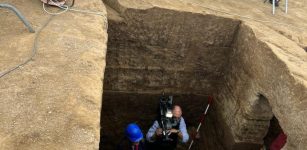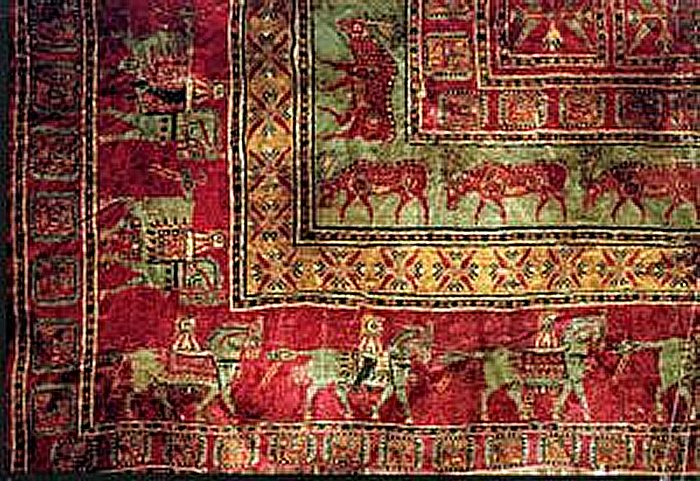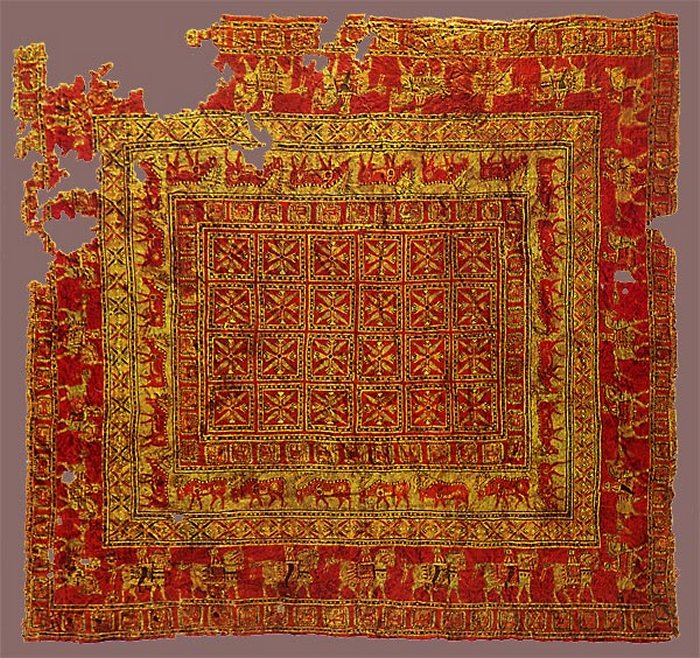Pazyryk Carpet Found In Scythian Tomb Considered The Oldest Carpet In The World
A. Sutherland - AncientPages.com - Russian archeologist Sergei Rudenko made an extraordinary discovery in 1949 while excavating burial mounds and a Scythian prince's tomb in southern Siberia.
 Pazyryk Carpet. Image source
Pazyryk Carpet. Image source
The place of the discovery was the so-called Pazyryk Valley, Altai Territory, in the region of the Bolshoy Ulagan River. In his excavations, Rudenko focused on the ancient history of weaving.
The tomb of a Scythian Prince dating back to 500 BC contained many treasures, and among them was the Pazyryk Carpet, measuring 183cm x 200cm and made by skilled craftsmen. It was created by using the traditional Turkish knotting system. The ancient rug is finely knotted with an average of 200 to 270 symmetrical knots to the square inch.
The tradition of making this kind of carpet originates from the nomadic Turkish tribes who occupied central Asia two millennia ago. However, this unbroken tradition of rug-making survived with that of more modern practices.
The carpet's decoration is vibrant and varied. The central part is covered with 24 cross-shaped figures, each consisting of 4 stylized lotus buds. This composition is framed by a border of griffins, followed by another one of 24 fallow deer. The most expansive of these two borders contains 28 figures of men on horseback and dismounted.
Naturally, the once bright yellows, blues, and reds of the carpet are not visible today, but initially, the rug must have displayed a beautifully glowing range of colors.
The Pazyryk carpet was made using the technique of the symmetrical double knot, the so-called Turkish knot, which means - 3600 knots per 1 dm2, so the whole carpet has more than 1,250,000 knots, and therefore this carpet pile is dense.
The origin of this unique Pazyryk carpet is not entirely known. Experts suggest that it may have a connection to Iran, but it perhaps was made somewhere in Central Asia thanks to the contacts of ancient people of the Altai Mountains with those from Iran and the Near East region.
Interestingly, the beautiful Pazyryk rug may represent only a copy of the original Persian piece of art.
The Pazyryk culture was a Scythian nomadic Iron Age archaeological culture of Iranian origin that lived c. 6th to 3rd centuries BC. Their identification was possible by unearthed artifacts and mummified humans found in the Siberian permafrost in the Altay (Altai) Mountains, Kazakhstan, and Mongolia.
Another Pazyryk rug. Circa 400 BC. Hermitage Museum - Image source - Schreiber - Public Domain
The Pazyryk's mummies were buried in long barrows (or kurgans), similar to the Scythian tomb mounds in Ukraine. Many artifacts and human remains were found at this location.
The culture flourished and benefited from the many trade routes and caravans of merchants passing through the area.
Ancient cultures flourished and disappeared for thousands of years in the Altai region, Siberia. Archaeologists have excavated the old burial complexes of the Pazyryk culture that existed in the Altai region about 2,500 years ago, from the end of 600 BC to the beginning of 200 BC.
Excavations revealed several skulls that offer evidence of sophisticated ancient surgical technologies and tombs with the bodies of horses and one with an embalmed body of a man whose body was decorated with tattoos depicting animal motifs. The remarkable textiles recovered from the Pazyryk burial tombs include the Pazyryk Carpet, pieces of woven Persian fabric, and the oldest embroidered Chinese silk.
Updated on Ocober 16, 2022
Written by – A. Sutherland - AncientPages.com Senior Staff Writer
Copyright © AncientPages.com All rights reserved. This material may not be published, broadcast, rewritten or redistributed in whole or part without the express written permission of AncientPages.com
Expand for referencesMore From Ancient Pages
-
 Fragarach: Supernatural Sword That Controlled Winds, Cut Through Wood, Metal And Bricks In Irish Myths And Legends
Celtic Mythology | May 14, 2020
Fragarach: Supernatural Sword That Controlled Winds, Cut Through Wood, Metal And Bricks In Irish Myths And Legends
Celtic Mythology | May 14, 2020 -
 Riddle Of The Old ‘Cursed’ Car – Supernatural Forces Or Unusual Coincidences?
Featured Stories | Dec 21, 2019
Riddle Of The Old ‘Cursed’ Car – Supernatural Forces Or Unusual Coincidences?
Featured Stories | Dec 21, 2019 -
 Evidence Of Copper Processing Unearthed At Archaeological Site In Oman
Archaeology | Mar 6, 2024
Evidence Of Copper Processing Unearthed At Archaeological Site In Oman
Archaeology | Mar 6, 2024 -
 Mysterious Hakkari Stelae: Were They Carved By Inhabitants Of Ancient Kingdom Of Hubushkia?
Artifacts | Nov 15, 2018
Mysterious Hakkari Stelae: Were They Carved By Inhabitants Of Ancient Kingdom Of Hubushkia?
Artifacts | Nov 15, 2018 -
 Monks Mound In Ancient Cahokia Was Not What Scientists Previously Thought – New Study
Archaeology | Jul 21, 2022
Monks Mound In Ancient Cahokia Was Not What Scientists Previously Thought – New Study
Archaeology | Jul 21, 2022 -
 Intact 2,600-Year-Old Etruscan Tomb Opened In Vulci- Exceptionally Rare Artifacts Found Inside
Archaeology | Oct 31, 2023
Intact 2,600-Year-Old Etruscan Tomb Opened In Vulci- Exceptionally Rare Artifacts Found Inside
Archaeology | Oct 31, 2023 -
 Ancient Mystery Of Italy’s Long-Lost Civilization That Pre-Dates The Ancient Roman Empire And Other Great Old Cultures
Civilizations | Mar 29, 2019
Ancient Mystery Of Italy’s Long-Lost Civilization That Pre-Dates The Ancient Roman Empire And Other Great Old Cultures
Civilizations | Mar 29, 2019 -
 King Midas’s Gold Desire Became A Nightmare
Featured Stories | Nov 2, 2023
King Midas’s Gold Desire Became A Nightmare
Featured Stories | Nov 2, 2023 -
 Njord: Norse God Of The Seas And Seafarers And His Unhappy Marriage To Skadi
Featured Stories | Jul 10, 2018
Njord: Norse God Of The Seas And Seafarers And His Unhappy Marriage To Skadi
Featured Stories | Jul 10, 2018 -
 On This Day In History: Vädersol Painting Depicting ‘Sun Dog’ Phenomenon Observed Over Stockholm – On Apr 20, 1535
News | Apr 20, 2017
On This Day In History: Vädersol Painting Depicting ‘Sun Dog’ Phenomenon Observed Over Stockholm – On Apr 20, 1535
News | Apr 20, 2017 -
 Unusual Iron Age Cemetery Discovered In Dorset, UK
Archaeology | Jul 11, 2022
Unusual Iron Age Cemetery Discovered In Dorset, UK
Archaeology | Jul 11, 2022 -
 Cosmic Rays Reveal Mysterious Void Inside Great Pyramid – What’s Hiding Inside?
Archaeology | Nov 2, 2017
Cosmic Rays Reveal Mysterious Void Inside Great Pyramid – What’s Hiding Inside?
Archaeology | Nov 2, 2017 -
 ‘The Domesday Book’ Of William I The Conqueror: Detailed Register Of ‘Who Owned What’ In England
Ancient History Facts | Jan 11, 2017
‘The Domesday Book’ Of William I The Conqueror: Detailed Register Of ‘Who Owned What’ In England
Ancient History Facts | Jan 11, 2017 -
 Controversial Unexplained Ancient Mystery In Mongolia – Discovery Of Remarkable Secrets Hidden In Artificial Cave – Part 1
Featured Stories | May 1, 2018
Controversial Unexplained Ancient Mystery In Mongolia – Discovery Of Remarkable Secrets Hidden In Artificial Cave – Part 1
Featured Stories | May 1, 2018 -
 Dispute Between Russia And Poland Over Discovery Of Czarist Officer’s Corpse In Turkey
Archaeology | Apr 10, 2018
Dispute Between Russia And Poland Over Discovery Of Czarist Officer’s Corpse In Turkey
Archaeology | Apr 10, 2018 -
 St. Simeon’s Monastery And History Of Its Founder Shed Light On Christian Past In Anatolia
Archaeology | Nov 28, 2020
St. Simeon’s Monastery And History Of Its Founder Shed Light On Christian Past In Anatolia
Archaeology | Nov 28, 2020 -
 Mysterious 4,000-Year-Old Table-Like And Unique Dolmen Discovered In Galilee Hills, Israel
Archaeology | Mar 6, 2017
Mysterious 4,000-Year-Old Table-Like And Unique Dolmen Discovered In Galilee Hills, Israel
Archaeology | Mar 6, 2017 -
 Horrifying Flying Head That Terrorized The Iroquois
Featured Stories | Sep 17, 2019
Horrifying Flying Head That Terrorized The Iroquois
Featured Stories | Sep 17, 2019 -
 Mysterious Biblical Canaanites – What Ancient DNA Reveals About Their Fate
Archaeology | Jul 28, 2017
Mysterious Biblical Canaanites – What Ancient DNA Reveals About Their Fate
Archaeology | Jul 28, 2017 -
 Egyptian Royal Artifacts Found At ‘Ancient Buto’ Site, Egypt Probably Dated To King Psamtik I’s Reign
Archaeology | Jan 4, 2018
Egyptian Royal Artifacts Found At ‘Ancient Buto’ Site, Egypt Probably Dated To King Psamtik I’s Reign
Archaeology | Jan 4, 2018


